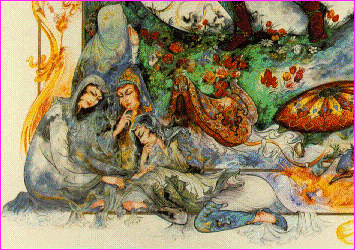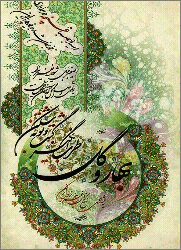
 |
In his article*, which is an abridgment of a 1971 article, Manoutchehr Mohandessi notes that there are elaborate references to Rilke's "The Notebooks of Malte Laurids Brigge" in Sadeq Hedayat's "The Blind Owl" ( "Buf-e Kur" ). The passages which Hedayat paraphrases from Rilke have been quoted to indicate that there are great similarities in idea and language between the two books.

The author states that "The Notebooks of Malte Laurids Brigge" is one of the two prose works of Rilke and although it is less well-known than his poetry, Rilke, himself, considers it of major importance, a key to his work. The book is a collection of reveries and reflections of a fictitious young Danish poet living in turn-of-the century Paris. "The Notebooks" is described by the author as "Introspective and retrospective, mystical and sensitive, and much concerned with loneliness, fear, suffering, and death." Like Rilke, Hedayat was an introvert and a sensitive man who was much concerned with the past and with mysticism, loneliness, fear and death. He, too, wrote his novel, "Buf-e Kur", in journal form with first person narrative. His novel is a tale told by a man who is physically and mentally ill, writing only "for his shadow." After comparing excerpts from Rilke's "The Notebooks" and from Hedayat's "Buf-e Kur", the author points to the similarities and differences between the two books. Among the similarities, the most striking one is the "prose poetry" of both books. Rilke, as a poet, has an extraordinary capacity to manipulate words to communicate images in his poetry. His novel, "The Notebooks", also abounds in the same kind of imagery that characterizes his poetry. Hedayat's "Buf-e Kur", too, is poetic and rhythmic. The second similarity is the dominant themes of both books which seem to be the past, loneliness, fear, and death. Similar symbols are also employed in both books. In spite of the above-mentioned similarities, the author suggests that the two books are different in story content. Unlike "Buf-e Kur", "The Notebooks" is not a novel. It is like a series of psychoanalytical sessions that Malte has with himself to explore his reflections and thoughts. Although "Buf-e Kur" is not a novel in any traditional sense, it has a plot while "The Notebooks" has no plot. By and large, the author argues that "Buf-e Kur" has no resemblance to Rilke's work in real time, place, and plot. At the end, the author emphasizes Rilke's influence on Hedayat by raising the same question that he has raised in the introductory paragraph of his article: "Is it possible that Hedayat felt closely identified with Malte Laurids Brigge and, in developing his central character, took for his very own some of Brigge's thoughts and words?"
 |
